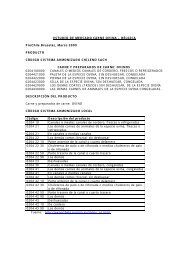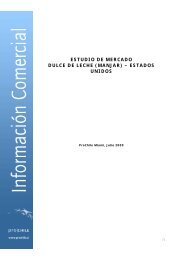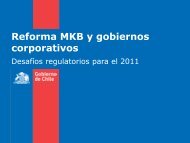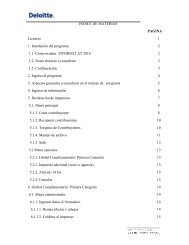M&A transactions in a post-reform marketplace Implications and ...
M&A transactions in a post-reform marketplace Implications and ...
M&A transactions in a post-reform marketplace Implications and ...
You also want an ePaper? Increase the reach of your titles
YUMPU automatically turns print PDFs into web optimized ePapers that Google loves.
M&A <strong>transactions</strong> <strong>in</strong><br />
a <strong>post</strong>-<strong>reform</strong> <strong>marketplace</strong><br />
<strong>Implications</strong> <strong>and</strong> opportunities<br />
for the bank<strong>in</strong>g <strong>in</strong>dustry<br />
The July 2010 passage of the Dodd-Frank Wall Street<br />
Reform <strong>and</strong> Consumer Protection Act, coupled with<br />
proposed Basel III <strong>reform</strong>s of capital <strong>and</strong> liquidity<br />
requirements, hold considerable implications for U.S.<br />
bank<strong>in</strong>g <strong>in</strong>dustry M&A activity. How might the various<br />
phases of an M&A transaction be impacted by recent<br />
f<strong>in</strong>ancial regulatory <strong>reform</strong>? Has <strong>reform</strong> generated M&A<br />
opportunities as well as challenges? From strategy to due<br />
diligence <strong>and</strong> <strong>in</strong>tegration, here are some important issues<br />
<strong>and</strong> challenges that bank<strong>in</strong>g organizations should consider<br />
when contemplat<strong>in</strong>g a merger, acquisition, or divestiture <strong>in</strong><br />
today’s chang<strong>in</strong>g regulatory environment.<br />
Dodd-Frank, Basel III highlights <strong>and</strong> impacts<br />
Although the Dodd-Frank legislation (Pub.L. 111-203,<br />
H.R. 4173, also known as F<strong>in</strong>ancial Regulatory Reform) is<br />
complex, its primary purpose is two-fold:<br />
• “De-risk” the f<strong>in</strong>ancial system by constra<strong>in</strong><strong>in</strong>g <strong>in</strong>dividual<br />
organizations’ risk-tak<strong>in</strong>g activities <strong>and</strong> captur<strong>in</strong>g a<br />
broader set of organizations <strong>in</strong> the regulatory net (e.g.,<br />
the so-called “shadow” bank<strong>in</strong>g system that historically<br />
has resided outside the regulators’ reach).<br />
• Provide greater consumer protections across both credit<br />
<strong>and</strong> debit services while cover<strong>in</strong>g a significantly broader<br />
group of participants.<br />
M&A Industry Advantage<br />
Bank<strong>in</strong>g<br />
From an M&A perspective, Dodd-Frank provides<br />
guidel<strong>in</strong>es on restrict<strong>in</strong>g/limit<strong>in</strong>g certa<strong>in</strong> bus<strong>in</strong>esses of<br />
bank<strong>in</strong>g <strong>in</strong>stitutions, which could <strong>in</strong>crease divestitures<br />
or sp<strong>in</strong>-offs of non-traditional bank operations, such as<br />
over-the-counter derivatives <strong>and</strong> <strong>in</strong>vestment management<br />
bus<strong>in</strong>esses. Of particular note is the so-called “Volcker<br />
Rule,” which requires federal “regulators to implement<br />
regulations for banks, their affiliates, <strong>and</strong> hold<strong>in</strong>g<br />
companies to prohibit proprietary trad<strong>in</strong>g, <strong>in</strong>vestment <strong>in</strong>,<br />
<strong>and</strong> sponsorship of hedge funds <strong>and</strong> private equity funds,<br />
<strong>and</strong> to limit relationships with hedge funds <strong>and</strong> private<br />
equity funds.” 1 (There is a de m<strong>in</strong>imus exception where<strong>in</strong><br />
banks could cont<strong>in</strong>ue to <strong>in</strong>vest up to three percent of their<br />
Tier 1 capital <strong>in</strong> private equity <strong>and</strong> hedge funds, not to<br />
exceed three percent of any s<strong>in</strong>gle fund’s total ownership<br />
<strong>in</strong>terest.)<br />
As a consequence of Volcker Rule restrictions, banks<br />
<strong>and</strong> bank-related entities will need to quickly explore tax<br />
<strong>and</strong> divestiture plann<strong>in</strong>g <strong>and</strong> strategy options related to<br />
restructur<strong>in</strong>g or dispos<strong>in</strong>g of exist<strong>in</strong>g proprietary trad<strong>in</strong>g<br />
<strong>and</strong> hedge <strong>and</strong> private equity fund operations. Although<br />
banks have a number of years <strong>in</strong> which to divest these<br />
assets — via closures, sp<strong>in</strong>-offs or sales — <strong>and</strong> push<br />
them off balance sheet, some large banks already have<br />
begun tak<strong>in</strong>g action, a signal that this process may not be<br />
someth<strong>in</strong>g that organizations should wait to address.<br />
1 “Brief Summary of the Dodd-Frank Wall Street Reform <strong>and</strong><br />
Consumer Protection Act,” http://bank<strong>in</strong>g.senate.gov/public/_<br />
files/070110_Dodd_Frank_Wall_Street_Reform_comprehensive_<br />
summary_F<strong>in</strong>al.pdf. Accessed September 14, 2010
Additionally, the shift<strong>in</strong>g of proprietary trad<strong>in</strong>g activities<br />
to permitted entities <strong>and</strong> the restriction from engag<strong>in</strong>g <strong>in</strong><br />
certa<strong>in</strong> trad<strong>in</strong>g activities could generate tension around<br />
the utilization of capital losses <strong>in</strong> exist<strong>in</strong>g entities, as well<br />
as create potentially <strong>in</strong>efficient tax characterization if<br />
conducted <strong>in</strong> special purpose vehicles.<br />
The Dodd-Frank legislation also provides for <strong>in</strong>creased<br />
regulatory scrut<strong>in</strong>y to identify <strong>and</strong> address systemic<br />
risks posed by large, complex companies, products, <strong>and</strong><br />
activities, 2 <strong>and</strong> limits certa<strong>in</strong> M&A activities of F<strong>in</strong>ancial<br />
Hold<strong>in</strong>g Companies (FHCs) <strong>and</strong> Bank Hold<strong>in</strong>g Companies<br />
(BHCs), <strong>in</strong> an effort to keep these entities well-capitalized<br />
<strong>and</strong> well-managed. Among the restrictions:<br />
• FHCs must get approval from the Federal Reserve (Fed)<br />
before acquir<strong>in</strong>g a non-bank company or f<strong>in</strong>ancial<br />
company with consolidated assets <strong>in</strong> excess of $25B.<br />
• For BHCs to acquire a bank located outside of the BHC’s<br />
home state, the result<strong>in</strong>g bank must be well-capitalized<br />
<strong>and</strong> well-managed.<br />
• BHCs with assets of $50B or more <strong>and</strong> systemically<br />
important non-bank f<strong>in</strong>ancial companies must obta<strong>in</strong> prior<br />
Fed approval to acquire companies with consolidated<br />
assets of $10B or more engaged <strong>in</strong> f<strong>in</strong>ancial activities<br />
made permissible by the Gramm-Leach-Bliley Act.<br />
• The law prohibits merg<strong>in</strong>g or acquir<strong>in</strong>g another company<br />
if the total consolidated deposit liabilities of the acquir<strong>in</strong>g<br />
f<strong>in</strong>ancial company exceed 10 percent of the liabilities of<br />
all f<strong>in</strong>ancial companies <strong>in</strong> the U.S.<br />
In addition to the U.S. f<strong>in</strong>ancial <strong>reform</strong> legislation, the Basel<br />
Committee on Bank<strong>in</strong>g Supervision announced September<br />
13, 2010, that the m<strong>in</strong>imum Tier 1 capital ratio would 2<br />
rise from 4 percent to 4.5 percent by 2013, <strong>and</strong> <strong>in</strong>crease<br />
to 6 percent <strong>in</strong> 2019. Banks also would have to keep a<br />
“conservation buffer” of 2.5 percent. 3 Banks <strong>in</strong> compliance<br />
with the m<strong>in</strong>imum ratios but fail<strong>in</strong>g to keep Tier 1<br />
capital above the “conservation buffer” 4 are encouraged<br />
to ma<strong>in</strong>ta<strong>in</strong> “prudent earn<strong>in</strong>g retention policies” <strong>and</strong>,<br />
therefore, could need to curtail payouts, such as dividends<br />
<strong>and</strong> bonuses. 5 Basel III also limits the def<strong>in</strong>ition of what<br />
<strong>in</strong>struments qualify as Tier 1 capital, result<strong>in</strong>g <strong>in</strong> many<br />
hybrid capital <strong>in</strong>struments no longer receiv<strong>in</strong>g Tier 1<br />
treatment. Those capital <strong>in</strong>struments that no longer qualify<br />
will be excluded from Tier 1 capital effective January 1,<br />
2013, or will be permitted to be phased out over a 10-year<br />
horizon beg<strong>in</strong>n<strong>in</strong>g January 1, 2013, for <strong>in</strong>struments that<br />
meet certa<strong>in</strong> conditions. 6<br />
The new capital requirements may cause f<strong>in</strong>ancial<br />
<strong>in</strong>stitutions to issue additional capital. For certa<strong>in</strong> smaller<br />
<strong>in</strong>stitutions, issu<strong>in</strong>g significant m<strong>in</strong>ority equity ownership<br />
to <strong>in</strong>vestors such as private equity firms could cause such<br />
<strong>in</strong>stitutions to undergo an “ownership change” for tax<br />
purposes, thereby potentially limit<strong>in</strong>g the entity’s ability to<br />
use its tax losses <strong>and</strong> other tax attributes to offset future<br />
taxable <strong>in</strong>come.<br />
<strong>Implications</strong> for Bank<strong>in</strong>g Industry M&A activity<br />
As the Dodd-Frank legislation <strong>and</strong> Basel III <strong>reform</strong>s are<br />
translated <strong>in</strong>to regulation over the com<strong>in</strong>g months <strong>and</strong><br />
years, Deloitte anticipates significant changes <strong>in</strong> future<br />
bank<strong>in</strong>g <strong>in</strong>dustry M&A activity. As mentioned earlier,<br />
limitations on derivatives activities <strong>and</strong> new restrictions<br />
on non-traditional bank<strong>in</strong>g operations <strong>in</strong> bank <strong>in</strong>stitutions<br />
imposed by the Volcker Rule may lead banks to divest<br />
these bus<strong>in</strong>esses.<br />
In addition to the more str<strong>in</strong>gent def<strong>in</strong>ition of Tier 1 capital<br />
<strong>and</strong> the heightened requirements, new rules will likely<br />
lead to substantial <strong>in</strong>creases <strong>in</strong> regulatory compliance <strong>and</strong><br />
costs, which may have a more dramatic impact on smaller<br />
banks. As such, consolidation of more traditional bank<strong>in</strong>g<br />
<strong>in</strong>stitutions may cont<strong>in</strong>ue, to take advantage of scale <strong>and</strong><br />
synergies.<br />
2 Ibid<br />
3 “Group of Governors <strong>and</strong> Heads of Supervision announces higher<br />
global m<strong>in</strong>imum capital st<strong>and</strong>ards,” press release, Basel Committee<br />
on Bank<strong>in</strong>g Supervision, September 12, 2010, http://www.bis.org/<br />
press/p100912.htm. Accessed October 21, 2010<br />
4 Ibid<br />
5 Ibid<br />
6 Ibid<br />
M&A <strong>transactions</strong> <strong>in</strong> a <strong>post</strong>-<strong>reform</strong> <strong>marketplace</strong> 2
As used <strong>in</strong> this document,<br />
“Deloitte” means Deloitte &<br />
Touche LLP, Deloitte Consult<strong>in</strong>g<br />
LLP, Deloitte F<strong>in</strong>ancial Advisory<br />
Services LLP, <strong>and</strong> Deloitte Tax LLP,<br />
which are separate subsidiaries<br />
of Deloitte LLP. Please see<br />
www.deloitte.com/us/about for<br />
a detailed description of the legal<br />
structure of Deloitte LLP <strong>and</strong> its<br />
subsidiaries.<br />
Those <strong>in</strong>stitutions largely unaffected by the new regulatory<br />
changes — <strong>in</strong>vestment management firms, exchanges,<br />
nonbank broker dealers, <strong>and</strong> private equity funds — may<br />
be well-positioned to purchase the assets shed by banks<br />
<strong>and</strong> <strong>in</strong>crease market share <strong>and</strong> scale. Particularly appeal<strong>in</strong>g<br />
to private equity funds may be <strong>in</strong>vestment management<br />
operations, which <strong>in</strong> addition to be<strong>in</strong>g cash-rich, are not as<br />
capital-<strong>in</strong>tensive or as regulated as other l<strong>in</strong>es of bus<strong>in</strong>ess.<br />
Cont<strong>in</strong>ued fallout from the U.S. f<strong>in</strong>ancial crisis is also<br />
expected to drive bank<strong>in</strong>g <strong>in</strong>dustry M&A over the<br />
next two-to-four years. The crisis has forced everyone<br />
to conserve capital, focus on liquidity, cash, <strong>and</strong> risk<br />
management. More than 800 banks rema<strong>in</strong> on the FDIC’s<br />
troubled or watch lists; stronger, healthier banks may<br />
decide to buy weaker, at-risk <strong>in</strong>stitutions whose share<br />
prices are languish<strong>in</strong>g, capital levels are low, or who are<br />
not sizeable or strong enough to rema<strong>in</strong> <strong>in</strong>dependent.<br />
However, even though distressed organizations may offer<br />
an unprecedented opportunity to purchase a bank at<br />
a good price, the size of the <strong>in</strong>stitutions on the list are<br />
believed to be smaller than a year ago, mak<strong>in</strong>g them less<br />
appeal<strong>in</strong>g franchises to acquire given their lack of scale <strong>and</strong><br />
deep client footpr<strong>in</strong>t. Also, some of the federal f<strong>in</strong>ancial<br />
Figure 1: M&A Lifecycle<br />
Key<br />
phases<br />
Synergy capture<br />
Strategy<br />
Performance<br />
improvement<br />
Target screen<strong>in</strong>g<br />
Integration <strong>and</strong> divestiture<br />
...that expedites <strong>in</strong>tegration <strong>and</strong> drives value<br />
Customers <strong>and</strong><br />
markets<br />
Due diligence<br />
Benefit<br />
rationalization<br />
Legal entity<br />
rationalization<br />
<strong>and</strong> tax <strong>in</strong>centives are go<strong>in</strong>g or have gone away, so the<br />
deals could appear less attractive than they were <strong>in</strong> 2009<br />
<strong>and</strong> early 2010. Another reason: Strong strategic buyers<br />
(primarily large banks) may be more <strong>in</strong>terested <strong>in</strong> M&A<br />
<strong>transactions</strong> that build out their franchise, products, <strong>and</strong>/<br />
or geographic reach. F<strong>in</strong>ally, mid-tier banks — the 120 or<br />
so organizations that comprise about a third of total U.S.<br />
bank<strong>in</strong>g assets, may look to consolidate to <strong>in</strong>crease their<br />
critical mass, economies of scale, <strong>and</strong> market presence.<br />
Manag<strong>in</strong>g the <strong>post</strong>-<strong>reform</strong> M&A life cycle<br />
The bank<strong>in</strong>g <strong>in</strong>dustry may see a short-term period of<br />
reduced, large-scale M&A activity until the big banks digest<br />
Dodd-Frank <strong>and</strong> Basel III <strong>and</strong> get comfortable with their<br />
capital levels. The top four banks are also approach<strong>in</strong>g the<br />
10% cap noted earlier, so M&A activity would likely need<br />
to come from banks 5-50, particularly those with exist<strong>in</strong>g<br />
excess capital levels.<br />
Because the F<strong>in</strong>ancial Reform <strong>and</strong> Basel committee<br />
changes may impact all stages of the M&A lifecycle —<br />
Strategy, Target Screen<strong>in</strong>g, Due Diligence, Transaction<br />
Execution, Integration, <strong>and</strong> Divestiture — banks of all sizes<br />
should consider adopt<strong>in</strong>g a multidiscipl<strong>in</strong>ary, <strong>in</strong>tegrated<br />
approach to plann<strong>in</strong>g <strong>and</strong> implementation across an entire<br />
transaction (Figure 1).<br />
Transaction execution<br />
Target<br />
Implementation Plann<strong>in</strong>g<br />
Merger<br />
Implement-<br />
Screen<strong>in</strong>g<br />
Synergy <strong>and</strong><br />
Clos<strong>in</strong>g <strong>and</strong><br />
Buy side Strategy<br />
Prelim<strong>in</strong>ary<br />
Negotiation<br />
Sell side<br />
ation <strong>and</strong><br />
<strong>and</strong><br />
Value Driver<br />
Execution of<br />
Develop-<br />
Due<br />
of Letter<br />
Transaction<br />
Identifi- Strategy <strong>and</strong> target identification Quantifi-<br />
Def<strong>in</strong>itive Negotiation Realiz<strong>in</strong>g value Implement-<br />
The<br />
ment<br />
Diligence<br />
of Intent F<strong>in</strong>ancial<br />
Clos<strong>in</strong>g<br />
M&A process cation is grounded <strong>in</strong> discipl<strong>in</strong>ed strategy cation <strong>and</strong> target selection<br />
Due Value of F<strong>in</strong>al optimization<br />
ation Plan<br />
Model<strong>in</strong>g<br />
Preparation<br />
Diligence Transaction<br />
Objectives • Carve-out<br />
Key areas of due diligence<br />
• Divestitures • Recommended<br />
Due diligence should focus on key value drivers <strong>and</strong> risk<br />
• Sp<strong>in</strong>-off<br />
<strong>in</strong>vestment<br />
Board or Steer<strong>in</strong>g<br />
Completed letter Term Executed<br />
F<strong>in</strong>ancial <strong>and</strong> tax Commercial Regulatory <strong>and</strong> compliance<br />
• Recapitalization considerations<br />
Transfer of<br />
Committee approval<br />
of <strong>in</strong>tent sheet<br />
• Jo<strong>in</strong>t ventures •purchase<br />
Information ownership/<br />
• Quality of earn<strong>in</strong>gs<br />
• Market perspectives • Fraud <strong>and</strong> corruption risk<br />
agreement memor<strong>and</strong>um clos<strong>in</strong>g<br />
• Asset quality<br />
• Operational<br />
• Background <strong>in</strong>vestigation<br />
• Valuation documentation<br />
• Structur<strong>in</strong>g alternative<br />
performance • Foreign Corrupt Practices Act (FCPA)<br />
• Reverse due diligence<br />
• Tax diligence <strong>and</strong> structur<strong>in</strong>g • Customer analysis • Anti-money launder<strong>in</strong>g (AML)<br />
• Account<strong>in</strong>g policy<br />
• Market<strong>in</strong>g<br />
• Import/export controls (OFAC, ITAR)<br />
• Pension/benefits<br />
• Intellectual property • Hart-Scott-Rod<strong>in</strong>o<br />
• Environmental <strong>and</strong> susta<strong>in</strong>ability<br />
• Regulatory<br />
Decision framework<br />
...which gets synthesized <strong>in</strong> to a decision framework<br />
• Fairness op<strong>in</strong>ions<br />
Underperform<strong>in</strong>g bus<strong>in</strong>ess<br />
Objectives • Performance<br />
• Restructur<strong>in</strong>g <strong>and</strong> improvement<br />
turnaround recommendations<br />
• Bankruptcy <strong>and</strong> • Cost structure analysis<br />
reorganization • Liquidity management<br />
• Dispute resolution assistance<br />
• Asset dispositions<br />
Sell side<br />
advisory<br />
• Accretion/dilution analysis<br />
• Purchase account<strong>in</strong>g —<br />
SFAS 141(R)<br />
• Strutur<strong>in</strong>g<br />
• Synergy analysis<br />
Deal model <strong>and</strong> valuation<br />
bus<strong>in</strong>ess case M&A<br />
community <strong>and</strong> board<br />
communication<br />
• Deal pric<strong>in</strong>g <strong>and</strong> terms<br />
(SPA)<br />
• Negotiat<strong>in</strong>g strategy<br />
• Communication strategy<br />
recommendations<br />
• Debt restructur<strong>in</strong>g<br />
advice<br />
Integrated risk<br />
management<br />
Divestiture<br />
Integration<br />
M&A <strong>transactions</strong> <strong>in</strong> a <strong>post</strong>-<strong>reform</strong> <strong>marketplace</strong> 3
A bank’s <strong>post</strong>-<strong>reform</strong> M&A strategy may depend,<br />
<strong>in</strong> part, on where it falls <strong>in</strong> the f<strong>in</strong>ancial spectrum.<br />
If it is a diversified f<strong>in</strong>ancial <strong>in</strong>stitution, we believe<br />
trategy<br />
that its strategy should be to “reset the ship” so<br />
it is most effectively positioned to take advantage<br />
of divestiture opportunities <strong>in</strong> a more regulated<br />
environment. This means preserv<strong>in</strong>g capital, rationaliz<strong>in</strong>g<br />
the balance sheet, <strong>and</strong> comply<strong>in</strong>g with the various f<strong>in</strong>ancial<br />
<strong>reform</strong> acts by divest<strong>in</strong>g non-core bus<strong>in</strong>ess <strong>and</strong> assets.<br />
Strategy<br />
In contrast, we believe that smaller (mid-tier) banks<br />
with strong capital ratios (many of whom have been<br />
accumulat<strong>in</strong>g capital over the last 18 months) should<br />
consider ways to build their franchise <strong>and</strong> deposit footpr<strong>in</strong>t<br />
strategically through M&A. Good values abound relative<br />
to historic valuation multiples, both via open market <strong>and</strong><br />
FDIC-driven <strong>transactions</strong>, <strong>and</strong> these banks may be able to<br />
take advantage of acquisition opportunities while there is<br />
less competition from larger <strong>in</strong>stitutions.<br />
F<strong>in</strong>ancial Regulatory Reform almost encourages a bank<br />
to clean house, to divest itself of low-marg<strong>in</strong> lend<strong>in</strong>g<br />
operations <strong>and</strong> non-traditional bank<strong>in</strong>g bus<strong>in</strong>esses, to<br />
determ<strong>in</strong>e what area of bank<strong>in</strong>g it wants to focus on<br />
— geography, products, a particular customer segment<br />
— <strong>and</strong> to home <strong>in</strong> on that. This “back to basics” strategy<br />
also encourages bank executives to ask strategic questions<br />
such as: What is it we want to be? Are we go<strong>in</strong>g to be a<br />
bank operation or a non-bank operation? Given the new<br />
regulations, what is our plan to grow? Will that growth<br />
be organic, franchised, a merger of equals? Will we be a<br />
player <strong>in</strong> FDIC auctions? Each bank should consider where<br />
its profit potential will be <strong>and</strong> realign its M&A strategy <strong>in</strong><br />
accordance with the new regulations.<br />
Target screen<strong>in</strong>g<br />
Logically, a bank’s <strong>post</strong>-<strong>reform</strong> M&A strategy should<br />
drive the target screen<strong>in</strong>g process. For example, if an<br />
<strong>in</strong>stitution’s growth strategy <strong>in</strong>cludes pursu<strong>in</strong>g acquisitions<br />
via FDIC auctions, it is imperative to consider early <strong>in</strong> the<br />
screen<strong>in</strong>g process how a target bus<strong>in</strong>ess operates, its<br />
growth potential, <strong>and</strong> its liabilities. This assessment should<br />
be conducted promptly <strong>and</strong> efficiently, as the FDIC auction<br />
process itself is quite fast. (In a non-FDIC transaction a<br />
potential buyer typically has more time to evaluate the<br />
market, its competitors, <strong>and</strong> various aspects of the target<br />
bus<strong>in</strong>ess).<br />
Deloitte has observed that there is often more than one<br />
prospective buyer evaluat<strong>in</strong>g FDIC purchases. Because of<br />
high levels of <strong>in</strong>terest, banks look<strong>in</strong>g to buy should beg<strong>in</strong><br />
to screen potential c<strong>and</strong>idates before they are placed<br />
on the FDIC’s sale list. This <strong>in</strong>cludes review<strong>in</strong>g media<br />
coverage, f<strong>in</strong>ancial <strong>and</strong> regulatory materials, <strong>and</strong> other<br />
publicly published reports that may provide <strong>in</strong>formation to<br />
better position the buyer <strong>in</strong> the bidd<strong>in</strong>g process.<br />
One task to consider <strong>in</strong> the screen<strong>in</strong>g process — for both<br />
traditional bank<strong>in</strong>g <strong>in</strong>dustry M&A <strong>transactions</strong> as well as<br />
FDIC deals — is to underst<strong>and</strong> the target’s capital picture<br />
<strong>in</strong> the context of the <strong>post</strong>-clos<strong>in</strong>g comb<strong>in</strong>ed enterprise.<br />
Some of the requirements emerg<strong>in</strong>g from Basel III make<br />
certa<strong>in</strong> low-marg<strong>in</strong> bank bus<strong>in</strong>esses less attractive, given<br />
the potential deterioration of the overall enterprise capital<br />
picture, <strong>and</strong> others more attractive; careful scrut<strong>in</strong>y of<br />
all f<strong>in</strong>ancials may be necessary. Also, the account<strong>in</strong>g<br />
<strong>and</strong> tax ramifications of a <strong>post</strong>-<strong>reform</strong> M&A transaction<br />
can be onerous. Underst<strong>and</strong><strong>in</strong>g key triggers <strong>in</strong> the deal<br />
before gett<strong>in</strong>g too far down the path is likely important.<br />
Indemnification <strong>and</strong> other deal-related asset valuations<br />
can be confus<strong>in</strong>g, especially <strong>in</strong> a loss-shar<strong>in</strong>g scenario<br />
for distressed <strong>transactions</strong>, so pro forma the balance<br />
sheet <strong>and</strong> regulatory capital. Also, an underst<strong>and</strong><strong>in</strong>g of<br />
the part(s) of the target bank the buyer doesn’t want to<br />
keep <strong>and</strong> develop<strong>in</strong>g a strategy for carv<strong>in</strong>g them out or<br />
divest<strong>in</strong>g them <strong>post</strong>-acquisition should be considered.<br />
M&A <strong>transactions</strong> <strong>in</strong> a <strong>post</strong>-<strong>reform</strong> <strong>marketplace</strong> 4<br />
Target screeni
Due diligence<br />
Due diligence<br />
In addition to evaluat<strong>in</strong>g a target acquisition’s f<strong>in</strong>ancial<br />
strength by underst<strong>and</strong><strong>in</strong>g the quality of its assets,<br />
consideration should be given dur<strong>in</strong>g the due diligence<br />
process to underst<strong>and</strong><strong>in</strong>g the organization’s penetration<br />
<strong>in</strong>to specific customer segments <strong>and</strong> its share of wallet<br />
that may be of <strong>in</strong>terest to the buyer. Cont<strong>in</strong>uation of client<br />
base is often important, so what is the value of the bank’s<br />
clients? How “sticky” are its deposits? Also, what are the<br />
projected run rate revenues <strong>and</strong> expenses <strong>in</strong> the <strong>post</strong>clos<strong>in</strong>g<br />
environment?<br />
Answer<strong>in</strong>g such questions can help to quantify the<br />
potential profitability of the bus<strong>in</strong>ess under a new<br />
corporate umbrella. It also can help to determ<strong>in</strong>e whether<br />
a particular bus<strong>in</strong>ess offers long-term value. Some banks<br />
are rush<strong>in</strong>g to purchase divested or distressed operations<br />
because current prices are low; however, the due diligence<br />
process may reveal that an operation might not be<br />
commercially viable <strong>and</strong> should be shut down rather than<br />
sold.<br />
The follow<strong>in</strong>g bank<strong>in</strong>g <strong>in</strong>dustry lead<strong>in</strong>g practices may help<br />
potential buyers to navigate a transaction’s due diligence<br />
phase. Suggestions <strong>in</strong>clude:<br />
• Identify<strong>in</strong>g items that could potentially have a cont<strong>in</strong>u<strong>in</strong>g<br />
significant impact (positive or negative) on future<br />
earn<strong>in</strong>gs, <strong>in</strong>clud<strong>in</strong>g nonrecurr<strong>in</strong>g or one-time revenue or<br />
expense items;<br />
• Review<strong>in</strong>g the target’s valuation methodologies,<br />
reflect<strong>in</strong>g the effects of the proposed transaction under<br />
the applicable account<strong>in</strong>g st<strong>and</strong>ards (e.g., U.S. GAAP,<br />
IFRS, etc.), as well as assess<strong>in</strong>g recorded assets to obta<strong>in</strong><br />
an underst<strong>and</strong><strong>in</strong>g of their related impact on future<br />
earn<strong>in</strong>gs <strong>and</strong> cash flows that might be significant;<br />
• Underst<strong>and</strong><strong>in</strong>g the type, amount <strong>and</strong> tim<strong>in</strong>g of potential<br />
operat<strong>in</strong>g <strong>and</strong> non-operat<strong>in</strong>g cash flows that could<br />
have a significant cont<strong>in</strong>u<strong>in</strong>g impact on future earn<strong>in</strong>gs<br />
or liquidity, as well as significant liabilities that may<br />
be triggered as a result of the proposed transaction,<br />
<strong>in</strong>clud<strong>in</strong>g the impact of employment benefit programs<br />
offered by the target;<br />
• Evaluat<strong>in</strong>g the target’s credit underwrit<strong>in</strong>g <strong>and</strong> risk<br />
mitigation policies, processes, controls <strong>and</strong> procedures,<br />
<strong>in</strong>clud<strong>in</strong>g perform<strong>in</strong>g a loan file review of a sample of<br />
the portfolio;<br />
• Gaug<strong>in</strong>g significant taxes that the target may be<br />
subject to, estimat<strong>in</strong>g the effective <strong>in</strong>come tax rate, <strong>and</strong><br />
dist<strong>in</strong>guish<strong>in</strong>g significant book/tax differences;<br />
• Exam<strong>in</strong><strong>in</strong>g the target’s IT <strong>in</strong>frastructure <strong>and</strong> the level of<br />
technology employed, <strong>in</strong>clud<strong>in</strong>g capacity for growth <strong>and</strong><br />
future projects;<br />
• Exam<strong>in</strong><strong>in</strong>g regulatory compliance/exposures, <strong>in</strong>clud<strong>in</strong>g<br />
Anti-money Launder<strong>in</strong>g (AML) <strong>and</strong> Office of Foreign<br />
Assets Control (OFAC) issues, as well as underst<strong>and</strong><strong>in</strong>g<br />
the m<strong>in</strong>imum regulatory capital requirements of the local<br />
markets <strong>and</strong> any implicit seasonality or volatility.<br />
Transaction execution<br />
Bank<strong>in</strong>g <strong>in</strong>dustry M&A <strong>transactions</strong> — particularly<br />
larger ones — will likely attract more regulatory<br />
scrut<strong>in</strong>y <strong>in</strong> a <strong>post</strong>-<strong>reform</strong> era. In addition, the Office of<br />
Thrift Supervision’s (OTS) traditional role of approv<strong>in</strong>g<br />
<strong>transactions</strong> is be<strong>in</strong>g transitioned to the Office of the<br />
Comptroller of the Currency (OCC), which will result<br />
<strong>in</strong> some banks hav<strong>in</strong>g to deal with a new regulator.<br />
Therefore, effective contract negotiations — whether the<br />
deal is with the FDIC or an open market transaction — are<br />
a critical part of transaction execution.<br />
For traditional open market deals, a well-def<strong>in</strong>ed<br />
transaction agreement is particularly important for<br />
carve-out <strong>transactions</strong>, given that the seller’s parent<br />
rema<strong>in</strong>s <strong>post</strong>-close, which provides an ongo<strong>in</strong>g enterprise<br />
to give strength to any <strong>in</strong>demnities per the agreement.<br />
Additionally, a clear transaction agreement provides<br />
greater protection when us<strong>in</strong>g cont<strong>in</strong>gent consideration as<br />
part of the purchase price, whether it <strong>in</strong>volves an earn-out<br />
or escrow<strong>in</strong>g a portion of the proceeds based upon a<br />
certa<strong>in</strong> acquired asset pool’s performance. It may also<br />
be important to consider early <strong>in</strong> the process transition<br />
services so that the buyer can successfully operate the<br />
enterprise on Day 1 <strong>and</strong> is not forced to rely on the seller<br />
or another vendor at the 11th hour, possibly result<strong>in</strong>g <strong>in</strong><br />
less-than-optimal pric<strong>in</strong>g for those services.<br />
In FDIC deals, underst<strong>and</strong><strong>in</strong>g terms of the transaction<br />
related to loss shar<strong>in</strong>g agreements, asset disposal, <strong>and</strong> loan<br />
modifications, is an important consideration. Additionally,<br />
a buyer should be m<strong>in</strong>dful of potential f<strong>in</strong>ancial terms<br />
beyond the clos<strong>in</strong>g consideration, <strong>in</strong>clud<strong>in</strong>g claw backs,<br />
first loss tranches, <strong>and</strong> equity appreciation rights.<br />
M&A <strong>transactions</strong> <strong>in</strong> a <strong>post</strong>-<strong>reform</strong> <strong>marketplace</strong> 5<br />
execution
Integra The current bank<strong>in</strong>g market may offer better<br />
accessibility to M&A opportunities than ever<br />
before; however, it also may present banks<br />
with the potential risk of los<strong>in</strong>g customers<br />
<strong>and</strong> employee talent — particularly dur<strong>in</strong>g the<br />
<strong>in</strong>tegration phase of an M&A transaction — as the<br />
dust from the transaction settles <strong>and</strong> the economy<br />
beg<strong>in</strong>s to recover. Therefore, banks engag<strong>in</strong>g <strong>in</strong> an M&A<br />
transaction should be cognizant to protect br<strong>and</strong> value,<br />
shareholder value, personnel, <strong>and</strong> customers, particularly<br />
dur<strong>in</strong>g the <strong>in</strong>tegration phase.<br />
Integration<br />
Bank customer loyalty has been deteriorat<strong>in</strong>g steadily<br />
<strong>in</strong>dustry-wide. Customers cite poor service (often the result<br />
of reduced frontl<strong>in</strong>e staff), added fees, credit restrictions,<br />
<strong>and</strong> higher borrower <strong>in</strong>terest rates as areas of discontent.<br />
To forestall additional, <strong>post</strong>-transaction customer erosion,<br />
banks might consider establish<strong>in</strong>g comprehensive Day<br />
1 programs to seamlessly connect with customers<br />
via enhanced communication, education, <strong>and</strong> loyalty<br />
<strong>in</strong>centives.<br />
F<strong>in</strong>ancial Regulatory Reform is likely to generate other<br />
<strong>in</strong>tegration-related challenges. Every bank<strong>in</strong>g <strong>in</strong>stitution<br />
will be subject to greater scrut<strong>in</strong>y under <strong>reform</strong>, which<br />
can add pressure to the process of comb<strong>in</strong><strong>in</strong>g two<br />
organizations Customer, employee <strong>and</strong> <strong>in</strong>vestor compla<strong>in</strong>ts<br />
might be more closely tracked, as might executive pay,<br />
general ledger (GL) report<strong>in</strong>g, legal entity report<strong>in</strong>g,<br />
<strong>and</strong> overall risk to the system. To properly manage this<br />
<strong>in</strong>creased regulatory oversight, bank personnel should<br />
work to thoroughly underst<strong>and</strong> the customer, operations,<br />
<strong>and</strong> f<strong>in</strong>ancial data associated with the <strong>in</strong>s-<strong>and</strong>-outs of<br />
daily bus<strong>in</strong>ess. As a result, data track<strong>in</strong>g <strong>and</strong> management<br />
likely will <strong>in</strong>crease <strong>in</strong> importance, as well as streaml<strong>in</strong>ed,<br />
transparent, <strong>and</strong> recognizable accountability to<br />
accommodate the new regulations.<br />
It is possible that the <strong>in</strong>dustry may see more divestitures<br />
<strong>post</strong>-acquisition, a consideration that may impact the<br />
<strong>in</strong>tegration phase. For example, a bank may want to buy<br />
a particular c<strong>and</strong>idate (e.g., a broker-dealer), but it has<br />
a piece of bus<strong>in</strong>ess (e.g., proprietary trad<strong>in</strong>g/PE) that will<br />
have <strong>post</strong>-<strong>reform</strong> punitive value from a regulatory capital<br />
usage perspective. In this case, the purchas<strong>in</strong>g <strong>in</strong>stitution<br />
may consider develop<strong>in</strong>g a Day 1 plan for its divestiture.<br />
Divestitures<br />
Banks seek<strong>in</strong>g to divest an asset — whether it is troubled,<br />
low-marg<strong>in</strong> or a non-traditional bank<strong>in</strong>g operation that<br />
must be shed due to new regulatory requirements — have<br />
an opportunity to achieve three important objectives:<br />
improve their liquidity, shr<strong>in</strong>k their balance sheet to more<br />
easily meet new capital requirements, <strong>and</strong> narrow their<br />
focus to the products, geographies <strong>and</strong>/or segments that<br />
offer more profit potential.<br />
Similar to the acquisition process, decid<strong>in</strong>g whether or<br />
not to divest part or all of an operation requires bank<br />
executives to ask some fundamental questions: What<br />
k<strong>in</strong>d of <strong>in</strong>stitution do we want to be? What is important<br />
to our customer base? Does this bus<strong>in</strong>ess support our<br />
growth strategies? How do we want to position our<br />
br<strong>and</strong>? How will a divestiture impact our overall legal <strong>and</strong><br />
regulatory structure? Once these <strong>and</strong> related questions<br />
have been answered, the bank should decide if it wants<br />
to completely divest the bus<strong>in</strong>ess or just move to a more<br />
limited <strong>in</strong>volvement (e.g., keep a m<strong>in</strong>ority stake of the<br />
management company <strong>and</strong> general partnership of an<br />
<strong>in</strong>vestment management subsidiary to be divested).<br />
The difference between a prepared or unprepared seller as<br />
the market stabilizes <strong>and</strong> beg<strong>in</strong>s to turn can significantly<br />
impact the price, terms, <strong>and</strong> execution of a divestiture.<br />
A prepared seller conducts its own assessment of the<br />
bus<strong>in</strong>ess be<strong>in</strong>g carved-out from the buyer’s perspective<br />
to better identify key issues that could affect valuation<br />
<strong>and</strong> the ability to close the deal. Also, the seller should<br />
carve-out the bus<strong>in</strong>ess’s assets <strong>and</strong> operations — its<br />
f<strong>in</strong>ancials, people, <strong>and</strong> processes — <strong>and</strong> anticipate<br />
the buyer’s needs for st<strong>and</strong>alone operations, ongo<strong>in</strong>g<br />
transition support, <strong>and</strong> regulatory requirements. Specific<br />
areas of preparation often <strong>in</strong>clude:<br />
• Assess<strong>in</strong>g the trend of historical regulatory <strong>and</strong> work<strong>in</strong>g<br />
capital <strong>and</strong> their related impact on a st<strong>and</strong>alone basis;<br />
• Conduct<strong>in</strong>g sell-side due diligence to identify issues with<br />
<strong>and</strong> gaps <strong>in</strong> f<strong>in</strong>ancial, tax, <strong>and</strong> operat<strong>in</strong>g data that will<br />
need to be addressed dur<strong>in</strong>g the buyer’s due diligence<br />
process;<br />
• Evaluat<strong>in</strong>g the need for <strong>and</strong> prepar<strong>in</strong>g carve-out<br />
f<strong>in</strong>ancials to satisfy regulatory <strong>and</strong> f<strong>in</strong>anc<strong>in</strong>g<br />
requirements;<br />
• Demonstrat<strong>in</strong>g how to operate the carve-out without its<br />
current parent company;<br />
• Provid<strong>in</strong>g detailed analysis around the current IT<br />
environment, <strong>in</strong>clud<strong>in</strong>g the current cost structure,<br />
expected future capital expenditures, <strong>and</strong> any<br />
dependencies on systems <strong>and</strong> personnel at the parent<br />
organization, as well as across divisions <strong>and</strong> geographic<br />
locations;<br />
• Del<strong>in</strong>eat<strong>in</strong>g the current employment benefits offered by<br />
the bus<strong>in</strong>ess <strong>and</strong> the result<strong>in</strong>g impact of the proposed<br />
transaction;<br />
• Provid<strong>in</strong>g a detailed analysis of any regulatory<br />
compliance/exposures <strong>and</strong> capital requirements.<br />
M&A <strong>transactions</strong> <strong>in</strong> a <strong>post</strong>-<strong>reform</strong> <strong>marketplace</strong> 6
Tax-related considerations for divestitures<br />
Alter<strong>in</strong>g or sell<strong>in</strong>g exist<strong>in</strong>g legal entities will trigger<br />
tax consequences <strong>and</strong> potentially expose f<strong>in</strong>ancial<br />
<strong>in</strong>stitutions to one-off costs <strong>and</strong> tax technical<br />
challenges. However, realign<strong>in</strong>g the organizational<br />
configuration <strong>and</strong> legal entity structure also<br />
presents opportunities that could reduce overall<br />
operat<strong>in</strong>g complexity <strong>and</strong> potentially provide tax<br />
benefits. Tax matters that may present themselves<br />
when <strong>in</strong>stitutions divest non-core bus<strong>in</strong>esses <strong>and</strong><br />
rationalize their legal entity structure <strong>in</strong>clude:<br />
• Transaction-related issues such as qualification<br />
of the transaction as a tax-free sp<strong>in</strong>-off or other<br />
tax-free reorganization, <strong>and</strong> tax issues regard<strong>in</strong>g<br />
loss on sale of subsidiary stock;<br />
• Tax attribute preservation <strong>and</strong> underst<strong>and</strong><strong>in</strong>g tax<br />
attributes of divested bus<strong>in</strong>esses, <strong>in</strong>clud<strong>in</strong>g E&P<br />
<strong>and</strong> tax basis;<br />
• Income tax account<strong>in</strong>g carve-out issues;<br />
• Tax-efficient deployment <strong>and</strong> repatriation of<br />
capital <strong>and</strong> other <strong>in</strong>ternational structur<strong>in</strong>g;<br />
• Transfer pric<strong>in</strong>g policies, which may be under<br />
<strong>in</strong>creased scrut<strong>in</strong>y via the <strong>in</strong>creased regulatory<br />
m<strong>and</strong>ates. At the same time, rationalization<br />
<strong>and</strong> rebalanc<strong>in</strong>g of global capital comb<strong>in</strong>ed<br />
with enhanced regulation <strong>and</strong> report<strong>in</strong>g<br />
will likely require new <strong>in</strong>tercompany pric<strong>in</strong>g<br />
methodologies <strong>and</strong> support<strong>in</strong>g documentation;<br />
• Multistate tax consequences stemm<strong>in</strong>g from<br />
both <strong>in</strong>ternal restructur<strong>in</strong>gs <strong>and</strong> external<br />
<strong>transactions</strong>;<br />
• Treatment of transaction costs;<br />
• Tax shar<strong>in</strong>g issues, <strong>in</strong>clud<strong>in</strong>g who is responsible<br />
for historical tax exposures;<br />
• Day 1 tax read<strong>in</strong>ess of divested <strong>and</strong> realigned<br />
bus<strong>in</strong>esses, <strong>in</strong>clud<strong>in</strong>g <strong>post</strong>-transaction<br />
preparedness with regard to transaction taxes,<br />
such as sales <strong>and</strong> use, VAT, <strong>and</strong> customs excises.<br />
Conclud<strong>in</strong>g thoughts<br />
Mitigat<strong>in</strong>g the challenges <strong>and</strong> maximiz<strong>in</strong>g the<br />
opportunities aris<strong>in</strong>g from the Dodd-Frank Act, Basel III,<br />
<strong>and</strong> other <strong>reform</strong> legislation may prompt banks to be more<br />
agile, flexible, <strong>and</strong> strategic than ever before.<br />
Currently, bank executives’ focus should be on<br />
underst<strong>and</strong><strong>in</strong>g F<strong>in</strong>ancial Regulatory Reform <strong>and</strong> its<br />
potential implications (e.g., smaller balance sheets, legal<br />
entity rationalization, decisions on non-bank operations,<br />
such as private equity <strong>and</strong> hedge funds, etc.) <strong>and</strong> on<br />
<strong>in</strong>vestigat<strong>in</strong>g which types of divestitures <strong>and</strong> acquisitions<br />
would be most accretive or create the most value under<br />
the new regulatory constra<strong>in</strong>ts. In this way, banks can<br />
more favorably position their organization to compete <strong>in</strong><br />
the <strong>post</strong>-<strong>reform</strong> l<strong>and</strong>scape.<br />
In addition, executives should underst<strong>and</strong> their<br />
organization’s growth objectives, what it is try<strong>in</strong>g to<br />
become, <strong>and</strong> how M&A can help to strengthen the<br />
bank’s presence <strong>in</strong> certa<strong>in</strong> products, segments, <strong>and</strong>/or<br />
geographies. Sometimes it is helpful to have an outside<br />
source look at the bank’s capabilities <strong>and</strong> its ability to<br />
execute <strong>transactions</strong> overall.<br />
F<strong>in</strong>ancial Regulatory Reform offers well-capitalized banks<br />
<strong>and</strong> other f<strong>in</strong>ancial <strong>in</strong>stitutions unprecedented M&A<br />
opportunities. However, once the FDIC auction process for<br />
attractive franchises subsides <strong>and</strong> non-traditional bank<strong>in</strong>g<br />
assets are divested, it may be years — even decades —<br />
before this volume of entic<strong>in</strong>g properties are aga<strong>in</strong> on<br />
the market. Reform will require a leanness that enables<br />
organizations to deal with all phases of the M&A process<br />
smoothly <strong>and</strong> effectively — no matter their size.<br />
M&A <strong>transactions</strong> <strong>in</strong> a <strong>post</strong>-<strong>reform</strong> <strong>marketplace</strong> 7
Please visit the onl<strong>in</strong>e merger <strong>and</strong> acquisition library<br />
which showcases the best current th<strong>in</strong>k<strong>in</strong>g about<br />
mergers, acquisitions <strong>and</strong> divestitures. If you’re look<strong>in</strong>g<br />
for guidance on how to tackle the toughest issues <strong>in</strong><br />
M&A today, we th<strong>in</strong>k you’ll f<strong>in</strong>d this a great place to<br />
start. Visit us at www.deloitte.com/us/MAlibrary.<br />
To receive a free subscription to the latest M&A-related<br />
thoughtware, newsletters, <strong>and</strong> events visit us at www.<br />
deloitte.com/us/MAsubscribe<br />
These materials <strong>and</strong> the <strong>in</strong>formation conta<strong>in</strong>ed here<strong>in</strong> are provided by Deloitte LLP <strong>and</strong> are <strong>in</strong>tended to provide general <strong>in</strong>formation on a particular<br />
subject or subjects <strong>and</strong> are not an exhaustive treatment of such subject(s). Accord<strong>in</strong>gly, the <strong>in</strong>formation <strong>in</strong> these materials is not <strong>in</strong>tended to<br />
constitute account<strong>in</strong>g, tax, legal, <strong>in</strong>vestment, consult<strong>in</strong>g or other professional advice or services. Before mak<strong>in</strong>g any decision or tak<strong>in</strong>g any action<br />
that might affect your personal f<strong>in</strong>ances or bus<strong>in</strong>ess, you should consult a qualified professional advisor.<br />
Copyright © 2010 Deloitte Development LLC. All rights reserved.<br />
Member of Deloitte Touche Tohmatsu Limited<br />
Authors<br />
Thomas Kaylor<br />
Pr<strong>in</strong>cipal<br />
Valuation Services<br />
Deloitte F<strong>in</strong>ancial Advisory Services LLP<br />
+1 212 436 2409<br />
Tkaylor@deloitte.com<br />
Paul Legere<br />
Pr<strong>in</strong>cipal<br />
M&A Consult<strong>in</strong>g Services<br />
Deloitte Consult<strong>in</strong>g LLP<br />
+1 312 486 2289<br />
plegere@deloitte.com<br />
Tom Rollauer<br />
Director<br />
Regulatory & Capital Markets Consult<strong>in</strong>g<br />
Deloitte & Touche LLP<br />
+1 212 436 4802<br />
trollauer@deloitte.com<br />
Jay Langan<br />
Partner<br />
M&A Transaction Services<br />
Deloitte & Touche LLP<br />
+1 212 436 2646<br />
jalangan@deloitte.com<br />
Anthony Passalaqua<br />
Director<br />
M&A Transaction Services<br />
Deloitte Tax LLP<br />
+1 212 436 5501<br />
apassalaqua@deloitte.com<br />
Andy Wilson<br />
Partner<br />
M&A Transaction Services<br />
Deloitte & Touche LLP<br />
+1 312 486 3587<br />
<strong>and</strong>wilson@deloitte.com
















